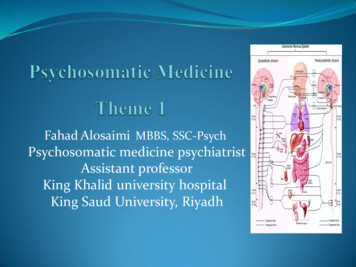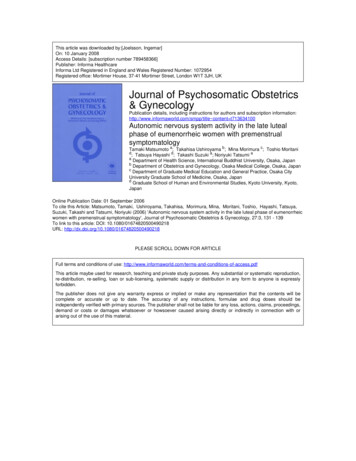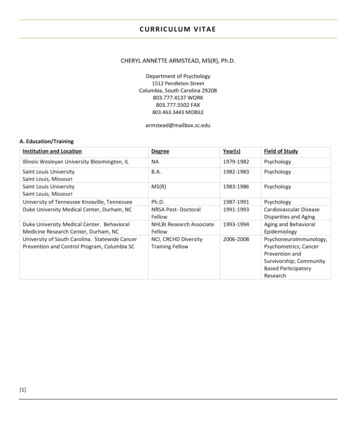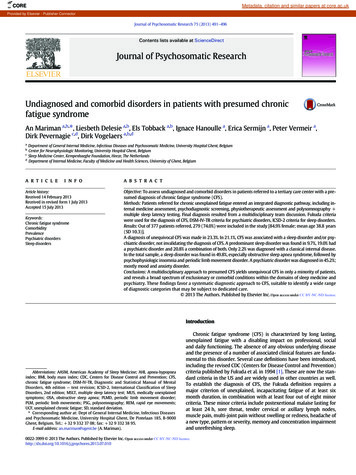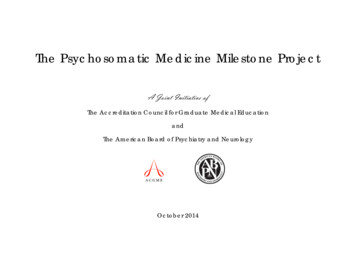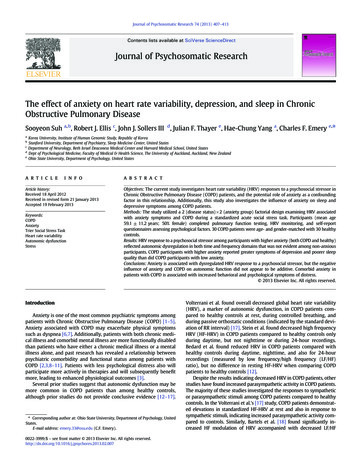
Transcription
Journal of Psychosomatic Research 74 (2013) 407–413Contents lists available at SciVerse ScienceDirectJournal of Psychosomatic ResearchThe effect of anxiety on heart rate variability, depression, and sleep in ChronicObstructive Pulmonary DiseaseSooyeon Suh a, b, Robert J. Ellis c, John J. Sollers III d, Julian F. Thayer e, Hae-Chung Yang a, Charles F. Emery e,⁎aKorea University, Institute of Human Genomic Study, Republic of KoreaStanford University, Department of Psychiatry, Sleep Medicine Center, United StatesDepartment of Neurology, Beth Israel Deaconess Medical Center and Harvard Medical School, United StatesdDept of Psychological Medicine, Faculty of Medical & Health Science, The University of Auckland, Auckland, New ZealandeOhio State University, Department of Psychology, United Statesbca r t i c l ei n f oArticle history:Received 18 April 2012Received in revised form 21 January 2013Accepted 19 February 2013Keywords:COPDAnxietyTrier Social Stress TaskHeart rate variabilityAutonomic dysfunctionStressa b s t r a c tObjectives: The current study investigates heart rate variability (HRV) responses to a psychosocial stressor inChronic Obstructive Pulmonary Disease (COPD) patients, and the potential role of anxiety as a confoundingfactor in this relationship. Additionally, this study also investigates the influence of anxiety on sleep anddepressive symptoms among COPD patients.Methods: The study utilized a 2 (disease status) 2 (anxiety group) factorial design examining HRV associatedwith anxiety symptoms and COPD during a standardized acute social stress task. Participants (mean age59.1 11.2 years; 50% female) completed pulmonary function testing, HRV monitoring, and self-reportquestionnaires assessing psychological factors. 30 COPD patients were age- and gender-matched with 30 healthycontrols.Results: HRV response to a psychosocial stressor among participants with higher anxiety (both COPD and healthy)reflected autonomic dysregulation in both time and frequency domains that was not evident among non-anxiousparticipants. COPD participants with higher anxiety reported greater symptoms of depression and poorer sleepquality than did COPD participants with low anxiety.Conclusions: Anxiety is associated with dysregulated HRV response to a psychosocial stressor, but the negativeinfluence of anxiety and COPD on autonomic function did not appear to be additive. Comorbid anxiety inpatients with COPD is associated with increased behavioral and psychological symptoms of distress. 2013 Elsevier Inc. All rights reserved.IntroductionAnxiety is one of the most common psychiatric symptoms amongpatients with Chronic Obstructive Pulmonary Disease (COPD) [1–5].Anxiety associated with COPD may exacerbate physical symptomssuch as dyspnea [6,7]. Additionally, patients with both chronic medical illness and comorbid mental illness are more functionally disabledthan patients who have either a chronic medical illness or a mentalillness alone, and past research has revealed a relationship betweenpsychiatric comorbidity and functional status among patients withCOPD [2,3,8–11]. Patients with less psychological distress also willparticipate more actively in therapies and will subsequently benefitmore, leading to enhanced physiological outcomes [3].Several prior studies suggest that autonomic dysfunction may bemore common in COPD patients than among healthy controls,although prior studies do not provide conclusive evidence [12–17].⁎ Corresponding author at: Ohio State University, Department of Psychology, UnitedStates.E-mail address: emery.33@osu.edu (C.F. Emery).0022-3999/ – see front matter 2013 Elsevier Inc. All rights 13.02.007Volterrani et al. found overall decreased global heart rate variability(HRV), a marker of autonomic dysfunction, in COPD patients compared to healthy controls at rest, during controlled breathing, andduring passive orthostatic conditions (indicated by the standard deviation of RR interval) [17]. Stein et al. found decreased high frequencyHRV (HF-HRV) in COPD patients compared to healthy controls onlyduring daytime, but not nighttime or during 24-hour recordings.Bedard et al. found reduced HRV in COPD patients compared withhealthy controls during daytime, nighttime, and also for 24-hourrecordings (measured by low frequency/high frequency (LF/HF)ratio), but no difference in resting HF-HRV when comparing COPDpatients to healthy controls [12].Despite the results indicating decreased HRV in COPD patients, otherstudies have found increased parasympathetic activity in COPD patients.The majority of these studies investigated the responses to sympatheticor parasympathetic stimuli among COPD patients compared to healthycontrols. In the Volterrani et al.'s [17] study, COPD patients demonstrated elevations in standardized HF-HRV at rest and also in response tosympathetic stimuli, indicating increased parasympathetic activity compared to controls. Similarly, Bartels et al. [18] found significantly increased HF modulation of HRV accompanied with decreased LF/HF
408S. Suh et al. / Journal of Psychosomatic Research 74 (2013) 407–413ratio from rest to peak exercise (bicycle ergometry) among patientswith COPD but not among healthy controls.Autonomic dysregulation indexed by decreased HRV may helpexplain elevated levels of anxiety and depression in COPD patients.Additionally, patients with anxiety disorders and anxiety symptoms, including panic anxiety, generalized anxiety disorder, and panicogenicmanipulations, may exhibit reduced HRV [19–30], suggesting that reduced HRV may be a physiological marker linked with clinical anxiety.However, no prior studies of COPD and HRV studies cited above[16–18] have addressed the role of anxiety in the relationship betweenCOPD and autonomic dysregulation.Although research to date is equivocal regarding the presence of autonomic dysregulation in COPD patients, it is important to determinethe degree to which autonomic dysregulation may be a component inthe pathophysiology of COPD, contributing to the exacerbation ofsymptoms (coughing and dyspnea) as well as poor emotion regulation(symptoms of anxiety). This study examined HRV response during anacute psychosocial stress task among COPD patients with and withoutanxiety compared to healthy controls with and without anxiety.Additionally, psychological variables were examined to compare sleepcomplaints and depressive symptoms in COPD patients with andwithout anxiety.In this study, “autonomic regulation” was operationalized as meaninterbeat intervals (mean RR) decreasing in response to a psychosocialstressor, and increasing during a Recovery phase. Any patterns that deviated from this expected response were operationalized as “autonomicdysregulation”.Four groups of participants were included: COPD patients with elevated anxiety (COPD-ANX), COPD patients without anxiety (COPD),healthy individuals with elevated anxiety (HEA-ANX), and healthyindividuals without elevated anxiety (HEA).Three primary hypotheses were evaluated: (1) The COPD-ANX groupwould exhibit autonomic dysregulation measured by HRV over andabove any dysregulation of the other three groups (COPD, HEA,HEA-ANX) in response to a psychosocial stressor; (2) Both anxiousgroups (COPD-ANX and HEA-ANX) would have elevated state anxietyat baseline and a blunted response of anxiety following a psychologicalstressor; and (3) The COPD-ANX group would report higher levels ofsleep complaints and depressive symptoms compared to the COPDgroup.ProcedureFollowing written consent, participants completed the State-TraitAnxiety Inventory — State version to identify high and low anxietygroups (COPD, COPD-ANX, HEA, HEA-ANX). The cut-off score was astandard clinically relevant value of 39 [32]. The target number of individuals in each group was 15, and individuals were deemed ineligible toparticipate after consenting to the study if the quota for a group hadbeen met. Eligible participants then completed pulmonary functiontesting and were fitted with HRV monitoring equipment to be wornthroughout the remainder of the experimental protocol.The study was divided into three phases: Baseline, Task, and Recovery, as shown in Fig. 1. At Baseline, all participants completed a packet ofself-report questionnaires. Following the questionnaires, participantsremained sitting quietly for 5 min to obtain a stable measure of HRVat rest. After quiet sitting, participants read aloud a neutral scriptabout doing laundry. Participants were asked to stop reading the neutral script after 1 min. During the Task phase, participants were exposedto the stressor task. A modified version of the Trier Social Stress Test(TSST) [33] was used for this study.For the modified TSST, the participant viewed videotaped instructions indicating that the participant would need to deliver a speech ona specified topic, and would be given 2 min to prepare. The participantwas informed that the speech would be videotaped and that the speechshould be 5 min long. When the taped instructions said “Please take2 min now to construct your speech”, a stopwatch was set for 2 min.After 2 min, the participant stood in front of the video camera, thevideo camera was switched on, and the participant delivered thespeech. If the participant remained silent for more than 20 s duringthe speaking period, the participant was prompted to continue speaking until the task was terminated.During the Recovery phase, each participant completed a poststressor questionnaire of state anxiety. The participant then listenedto relaxing music for 20 min.ConsentScreeningSTAI-X1Blood Pressure screening MethodsPulmonary Function TestingParticipantsSixty-nine individuals responded to the recruitment efforts andconsented to the procedure. However, six individuals were ineligiblefor the study because group quotas had been met. Of the 63 remainingparticipants, two individuals completed the study but did not meetcriteria for COPD and were excluded from analyses. One individual completed the study but was excluded from analyses due to HRV equipmentmalfunction. Therefore, 60 participants comprised the final sample,with 15 participants in each of the four experimental groups: COPD,COPD-ANX, HEA, and HEA-ANX.Participants were recruited from the pulmonary rehabilitation program at Ohio State University (OSU) and from the Columbus metropolitan area. This study was approved by the institutional review board atOSU. All participants with COPD had had a physician diagnosis of COPDfor at least 3 months. All diagnostic criteria were consistent with theGOLD standard [31] [indicated by forced expiratory volume in one second/forced vital capacity b .70 (FEV1/FVC b .70) and FEV1% predictedb.80].Participants were excluded if they were pregnant, taking betaantagonist medication, or had a history of cardiovascular disease. Participants with COPD who were eligible for the study were matched by age( 2 years) and gender to healthy individuals.Fitted with HRV equipmentBaseline Questionnaires Psychological Variables 5 minutes 1 minute 2 minute speech preparation5 minute speech delivery STAI-X120 minutes of relaxingmusicBaselinePhaseQuiet Sitting PeriodBaseline Speech(Neutral Script)Task PhaseRecoveryPhaseTask (Trier Social StressTask)RecoveryFig. 1. Study design.
S. Suh et al. / Journal of Psychosomatic Research 74 (2013) 407–413Physiological recordingA Polar S810i Fitness watch (Polar Electro, Finland; www.polar.fi/en/) was used to measure continuous R-to-R intervals using a thoracic band, which transmits and stores IBI at 1000 Hz on a wristwatch.Two previous validation studies [34,35] have compared the S810iwith standard ECG recordings during supine rest, walking, andexercise. Both studies concluded that time- and frequency-domainestimates of HRV obtained from IBI time series from the S810i versusa standard ECG system had very good intra-class correlation coefficients and limits of agreement.The IBI time series for periods of interest were processed using theKubios HRV Analysis Software (version 2.1; http://kubios.uku.fi/)which calculates HRV parameters in both time and frequencydomains per the Task Force Guidelines for HRV [36]. A single experienced rater, blinded to subject group membership, performed theHRV analyses. Within each of the TSST periods (Baseline, Task, Recovery), a single window of 132 to 250 s was selected (avoiding periodboundaries) to yield the least amount of artifact correction (piecewisecubic spline interpolation) and trend component removal (smoothness priors) performed by Kubios (i.e., the segment requiring theleast amount of adjustment for nonstationarity) [36,37]. A 2 2 3mixed-factorial ANOVA revealed no significant differences in segmentlength as a function of disease status [F (1, 53) .021, p .886],anxiety group [F (1, 53) .02, p .899], or phase [F (2106) .61,p .544].Three outcome measures were calculated from the IBI data withineach TSST period. In the time domain, mean IBI (mean RR) and thenatural log (ln) transformed value of the standard deviation of theIBI series (SDNN) were calculated. SDNN was used as a measure ofglobal HRV, which has been used in previous studies with COPD patients [17].As reviewed in the previous studies, in the frequency domain, spectral power estimates are obtained by integrating the autoregressive(AR) power spectrum after factorizing the spectrum into a lowfrequency and high-frequency component [36,38]. Because of the fastbreakdown of acetylcholine, PNS modulation of the heart is fast andshort-lived. Thus, the power in the high-frequency (HF) band(.15–.4 Hz) is dominated by PNS activity. The power in the lowfrequency (LF) band (.04–.15 Hz) is considered to reflect joint activation of the PNS and SNS [36]. In the present study, only the vagallymediated HF component was analyzed. The advantages of an AR solution are the smoother spectral components that are independent ofpre-specified frequency bands, clear central frequencies of eachcomponent, and an accurate estimation of power spectral densityeven on a small number of (stationary) samples [36]. Furthermore,the central frequency of the HF component has been shown to serveas a surrogate for respiration rate (i.e., frequency in Hz 60 RR)[39], and was calculated here.Self-report measures included the following assessments of healthbehavior and psychological distress:Smoking historyParticipants provided detailed information about lifetime durationand amount of cigarettes smoked. Pack-years of smoking (number ofpacks of cigarettes smoked per day number of years smoked thisamount) was calculated as a cumulative measure of exposure to smoking.SleepSleep disturbance has been indicated to affect over 50% of COPDpatients, which subsequently diminishes quality of life and increasesdisease burden [40]. To evaluate sleep disturbance, participants completed the Pittsburgh Sleep Quality Index (PSQI) [41], a self-reportquestionnaire assessing sleep quality and disturbances over aone-month interval. The scale yields a total score that ranges from 0409to 21, with higher scores indicating more difficulties with sleep. Aglobal score greater than 5 indicates a poor sleeper.AnxietyThe State-Trait Anxiety Inventory, (STAI-X1) State version [32] is a20-item measure of state anxiety. Items on the State version includestatements such as “I feel upset” and “I am presently worrying over possible misfortunes” rated on a scale of 1 to 4. For all items, respondentsindicate how they are feeling at the present moment. The STAI hasdemonstrated adequate reliability in older adults (α .94; 59). Internal reliability for this sample was excellent (Cronbach's alpha 0.94).DepressionThe Center for Epidemiological Studies Depression Scale (CESD) [42]is a 20-item measure of symptoms of depression. Respondents ratesymptoms of depression during the past week on a 4-point scale. ACESD score of 16 or greater is indicative of depressive symptomatology.The CESD demonstrates internal consistency with α .85. Internalreliability for this sample was excellent (Cronbach's alpha 0.93).Pulmonary functioningStandard pulmonary function testing equipment (Koko LegendPortable Spirometer) was used to determine the volume of expiredair, after a maximum inspiration, as well as the flow rate of air. Allpulmonary function testing adhered to American Thoracic Societyguidelines [43,44]. Common diagnostic measurements include bothFEV1 and FVC, measured in liters. Degree of COPD was characterizedfor each patient by the percent predicted FEV1 (according to normsfor age, race, sex, and height), and by the ratio FEV1/FVC.Data analysisThe current study utilized a 2 2 factorial design to compare thefour groups of participants: COPD patients with elevated anxiety(COPD-ANX), COPD patients without anxiety (COPD), healthy individuals with elevated anxiety (HEA-ANX), and healthy individualswithout elevated anxiety (HEA). For our first hypothesis, the primarymode of data analysis for HF-HRV and state anxiety was a 2 2 3(disease status anxiety group phase) repeated measures ANOVAwith disease state (COPD vs. non-COPD) and anxiety group (anxiousvs. non-anxious) as between subject variables and phase (Baseline,Task, Recovery) as the within subjects variable. We performedpre-planned trend analyses of the pattern of response among thegroups, as Baseline–Task–Recovery paradigms such as the TSST arelikely to elicit distinctive patterns of response in HRV [45,46]. Thus,a series of linear and quadratic pre-planned contrasts wereperformed to characterize responses across groups, as noted in theIntroduction. Post-hoc analyses included respiratory frequency (RF)as a covariate for all the HRV analyses.To control for multiple testing, a sequentially rejective Bonferronitest was used within the RR, SDNN, and HF analyses. This methodinvolves arranging the number of planned comparisons according top-values, and testing the smallest p-value against alpha (α; 0.05)divided by the number of comparisons (j) within each family. If andonly if this comparison was significant, we proceeded to test thenext smallest p-value against α / (j 1).This method conservatively protects each test performed, and theconditional nature of the procedure leads to a multiplicative, ratherthan additive compounding of error probability [47].For the second hypothesis, a 2 (group: COPD, COPD-ANX, HEA,HEA-ANX) 2 (phase: Baseline and Recovery) repeated measuresANOVA was conducted for state anxiety with group affiliation as thebetween subject variables and phase as the within subject variable.For the third hypothesis, pre-planned tests of group differences indepression and sleep quality were performed. A one-way ANOVA wasconducted for pulmonary functioning and psychological variables
410S. Suh et al. / Journal of Psychosomatic Research 74 (2013) 407–413Table 1Demographic characteristics of participantsAgeYears of educationYears since anMarital g status% current smokerFEV1FEV1%FVCFVC%FEV1/FVCGOLD criteriaStage IStage 2Stage 3Stage 4% use of prescribed medicationsCOPD (n 30)M (SD) or N (%)Healthy (n 30)M (SD) or N (%)59.114.374.926,60059.2 (11.28)16.0 (3.5)–31,700 (27,600)(11.24)(2.7)(3.5)(21,500)15 (50)15 (50)15 (50)15(50)17 (56.67)12 (40)0 (0)1 (3.33)23 (76.67)⁎⁎⁎4 (13.33)1 (3.33)2 (6.67)6 (20.7)10 (34.5)10 (34.5)3 (10.3)5 (16.7)9 (30)13 (43.3)3 )(20.77)(0.15)4 (13.3)13 (43.3)9 (30)4 (13.3)30 (100)2 (6.7)⁎⁎2.79 (0.81)⁎⁎⁎94.73 (19.99)⁎⁎⁎3.4 (1.01)⁎⁎⁎88.80 (18.10)⁎⁎⁎0.82 (0.06)⁎⁎⁎estimate was 0. These three “missing” values were replaced with the group mean forthat period (based on the mean of the remaining 14 participants) to avoid havingdifferent degrees of freedom across measures (or eliminating those three subjectsacross all measures).Mean RR2There was a significant main effect of Task phase on mean RR, characterized by both aquadratic [Fquad (1, 56) 215.42, p b .0001] and a linear [Flin (1, 56) 47.35, p b .0001]trend, with Recovery having a slower mean IBI than Baseline. As shown in Fig. 2a (with statistics in Table 2), these two trends were consistent across all four groups (COPD, COPD-ANX,HEA, and HEA-ANX).SDNN3Across all subjects, a significant linear trend [Flin (1, 56) 14.86, p b .001], but nota significant quadratic trend [Fquad (1, 56) 1.12, p .295] was present. As evidentin Fig. 2b (cf. Table 2), this difference was the result of significant linear trends onlyin the high anxiety groups (both HEA and COPD).HF-HRVConsistent with mean RR, both quadratic [Fquad (1, 56) 7.38, p .009] and linear [Flin (1, 56) 19.78, p b .0001] trends were present in the full data set. As seen inFig. 2c (cf. Table 2), linear effects were more pronounced for both HEA-ANX andCOPD-ANX than their non-anxious counterparts.All pre-planned comparisons continued to be significant after using sequentiallyrejective Bonferroni test to control for family-wise error within each family of HRVvariables (mean RR, SDNN, HF-HRV).A post-hoc analysis using smoking status and usage of prescribed medications as acovariate was conducted for HRV variables. Both smoking status and number ofmedications were not statistically significant in all trend analyses for all four groups(p-value .09).TSST psychological measures22 (73.3)Abbreviations: COPD Chronic Obstructive Pulmonary Disease; CA Caucasian;AA African American; FEV1 Forced Expiratory Volume in one second; and FVC Forced vital capacity;Note.M Mean.SD Standard Deviation.⁎ p b .05.⁎⁎ p b .01.⁎⁎⁎ p b .001.evaluating differences within disease status (COPD vs. COPD-ANX)and anxiety group (COPD-ANX vs. HEA-ANX). Post hoc analyseswith Tukey's HSD were used to analyze group differences.ResultsParticipants were asked to refrain from smoking, consuming alcohol or caffeine, or takinganxiolytic medication 24 h prior to participating in the study to avoid confounding of HRVmeasurements. Participants with COPD were asked to refrain from taking β2-agonistinhalers 6 h prior to the study to avoid confounding of HRV measurements.Mean age of participants was 59.1 ( 11.2) years (50% female). Participants withCOPD presented with moderately severe disease, indicated by a mean FEV1% predictedof 54.03 ( 22.11) and a FEV1/FVC ratio of 0.63 ( 0.15). Additional demographicinformation and baseline pulmonary function values of the sample are summarizedin Table 1.Participants with COPD (in the COPD and COPD-ANX groups) did not differ fromthe healthy controls (in the HEA and HEA-ANX groups) with regard to age, gender,marital status, income, or education (p-values .05). As expected, there were differences in pulmonary functioning among the two groups (p-values b .001). Therewere also significant racial differences between the groups.To ensure that changes in heart rate were not due to production of speech duringthe Task phase, independent t-tests for HRV in both time and frequency domainsbetween the resting baseline and baseline reading task (i.e., the 1-minute scriptabout laundry) revealed no significant differences in mean RR, SDNN, and HF-HRV.TSST physiological measures1Fig. 2 depicts HRV values in both the time and frequency domain for the fourgroups across the Baseline, Task, and Recovery phase, plotted separately by disease status. For HF-HRV, three subjects had a single period in which the autoregressive HF-HRV1There were no significant differences at baseline between groups for any HRVvariables.State anxiety was measured at Baseline and immediately after the Task. Repeatedmeasures ANOVA revealed significant time [F (3, 60) 18.24, p b .001] and group [F(3, 60) 2.59, p b .001] effects, and a non-significant interaction [F (3, 60) 2.59,p .06]. Tukey's HSD revealed significant differences between the anxious andnon-anxious groups (p b .001). Thus, state anxiety increased significantly fromBaseline to Task following a psychological stressor in the COPD and HEA group(non-anxious groups), but the COPD-ANX and HEA-ANX groups (anxious groups)had an elevated state anxiety at Baseline and did not show an increase following thepsychological stressor (see Fig. 2d).There were no significant differences between the COPD-ANX and HEA-ANX groupin pack-year history and depression (p-values .1), as shown in Table 3. However, theCOPD-ANX group reported lower overall sleep quality [t 2.74, p .01] than theHEA-ANX group.The COPD group and the COPD-ANX group did not differ in disease severity(t .10, p .91), but the COPD group had a higher pack-year history (t 2.45,p .02) compared to the COPD-ANX group, as shown in Table 4. The COPD groupalso exhibited less distress than the COPD-ANX group, with lower scores on the CESD(t 4.18, p b .001) and lower scores on the PSQI (t 3.49, p .002).DiscussionThis study is the first to examine the mediating role of anxiety in theautonomic dysregulation accompanying COPD. Participants with higheranxiety (both COPD and healthy) displayed similar HRV responsepatterns in both the time (SDNN) and frequency (HF-HRV) domains,that differed significantly from their non-anxious counterparts. Thesefindings suggest that anxiety may function as a confounding factorwhen characterizing HRV response to a psychosocial stressor.All four groups displayed strong quadratic trends for mean RR.These differences can also be appreciated visually (see Fig. 2), byexamining the strong “overlap” of error bars during the Baselineand Recovery stages (i.e., reflecting similar levels of activity at thegroup level). For SDNN and HF-HRV, by contrast, only the healthynon-anxious group displayed overlapping error bars for SDNN andHF-HRV. In the other three groups, Recovery values were substantially higher than Baseline values (especially in the case of HF-HRV). Thisindicates that anxiety (both in COPD and healthy participants) was2There were no significant interactions between the trends and disease status oranxiety group for mean RR.3There were no significant interactions between the trends and Disease Status orAnxiety group for SDNN.
S. Suh et al. / Journal of Psychosomatic Research 74 (2013) 700650COPD3.1SDNNMean RR411Base Speech Recov2.5Base Speech RecovBase Speech RecovBase Speech RecovNot AI-X1HF-HRV4.64.24.03.840303.63.420Base Speech RecovBase Speech RecovBaseRecovBaseRecovFig. 2. Dependent measures during the psychosocial stressor task (Baseline, Speech, and Recovery). Abbreviations: Mean RR mean interbeat intervals (in ms); SDNN standarddeviation of interbeat interval series; HF-HRV natural ln transformed high frequency value; and STAI-X1 State-Trait Anxiety Inventory, State version.associated with a blunted HF-HRV response prior to and after thestressor. This was also confirmed with subjective anxiety measuredby the STAI, which indicates that the anxious groups display highanxiety throughout the study and do not change from Baseline to Recovery, whereas the non-anxious groups exhibit increased symptomsof anxiety following the stressor. Thus, the anxious groups showanticipatory anxiety compared to their nonanxious counterparts.This is consistent with the past literature indicating that anxiousindividuals display a blunted response to stress due to having moreanticipatory anxiety at Baseline.Significant increasing linear trends were consistently present forboth SDNN and HF-HRV for only the anxious groups (COPD-ANXand HEA-ANX), but not for the nonanxious groups. These results areconsistent with prior research indicating that COPD patients exhibitincreased parasympathetic activity in response to sympathetic stimuli when compared to healthy controls [16,17]. Similar patterns werealso observed in healthy, anxious individuals. It is possible that pastTable 2Linear and quadratic trend analyses of the three phases (Baseline, Speech, Recovery) ofthe TSST, separate for each sub-group of 15 subjects. For abbreviations, see Fig. 2captionMeasureMean xNotAnxNotAnxNotAnxNotAnxNotAnxLinear trendQuadratic trendF (1, 56)pF (1, 27.447Abbreviations: Mean RR mean interbeat intervals, SDNN log-transformedstandard deviation of normal–normal beats; and HF-HRV log-transformed HighFrequency Value.studies investigating HRV in patients with COPD may have includeda heterogeneous sample with and without anxiety, and previousstudies of HRV in COPD patients may have been affected by the highprevalence of anxiety in this population, as none of the previous studies of HRV in COPD measured anxiety.Past investigators have suggested that elevated parasympatheticactivity in COPD patients may be influenced by breathing against resistance or that obstructed breathing may cause fluctuation in cardiacfunction in COPD patients [48,49]. Increased parasympathetic activitymay be potentiated during dynamic hyperinflation and increasedend-expiratory lung volumes [50]. However, the absence of any effectof RF in these data does not support this explanation. This is also supported by the previous studies showing that HRV was not solelyinfluenced by altered breathing pattern [13,17,18,51,52].Our study did not find decreased global HRV in COPD patientscompared to healthy controls, as found in past studies [17]. Inconsistent results across studies may reflect differences in the type of HRVmeasures and recording procedures used (e.g., utilizing short-termversus long-term HRV recordings). Volterrani et al. [17] found decreased global HRV indexed by the standard deviation of R–R intervals in COPD patients compared to healthy controls, but also foundan increased parasympathetic activity in COPD patien
b Stanford University, Department of Psychiatry, Sleep Medicine Center, United States c Department of Neurology, . This study was approved by the institutional review board at . 408 S. Suh et al. / Journal of Psychosomatic Research 74 (2013) 407-413. Physiological recording A Polar S810i Fitness watch (Polar Electro, Finland; www.polar .

